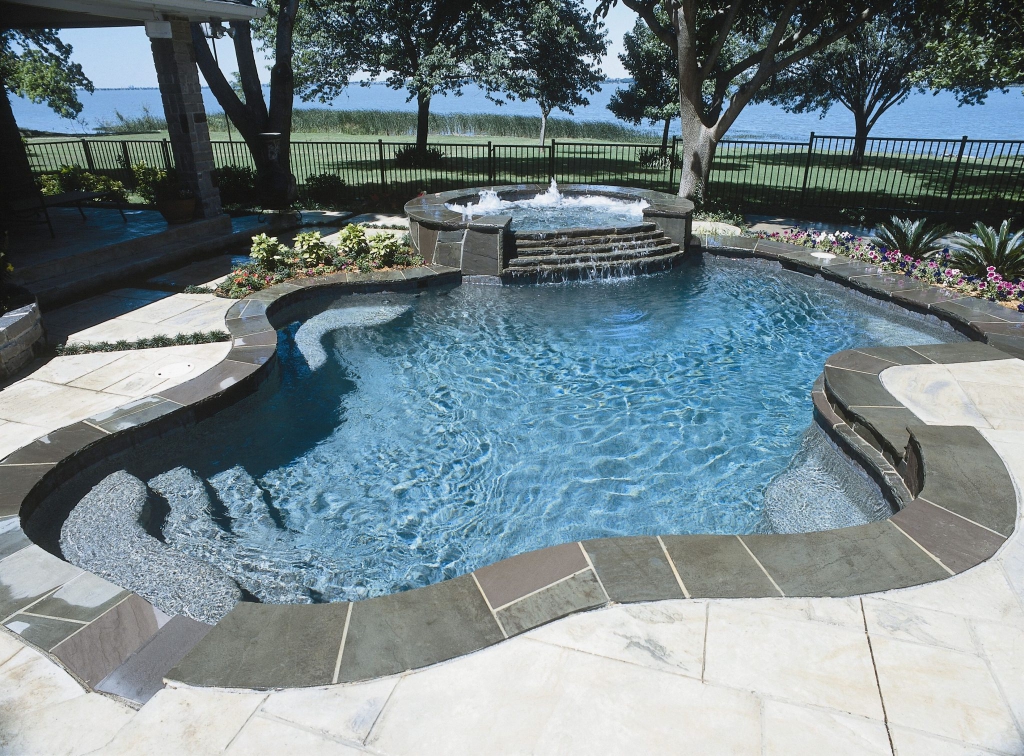
It takes time and effort to get the most out of an inground pool. You must consider not just the overall appearance but also the functionality and durability. These considerations converge near the pool’s edge, where the coping gets an opportunity to shine. Swimming pool coping adds a stylish layer of protection to your pool. If you own a pool, one should think about the pool coping for various reasons. For starters, pool coping increases durability and usefulness. Secondly, while pool coping prevents water damage, it provides something to grip onto while exiting the water.
What Is Pool Coping?

Pool coping refers to the material used during a capping or edging that surrounds the pool shell wall. Coping protects the pool structure by separating the pool shell from the adjacent surface area. Coping is intended to keep water from getting behind the pool shell, and if correctly built, splashed water should flow away from the pool & down into surrounding drains.
Pool coping is often designed with a lovely outward tilt. Pool builders commonly use different materials, pavers, and travertine. You may also use wood and metal, although they are prone to wear and tear due to the pool’s high moisture content. They are also more costly and need additional upkeep and attention.
Why Should One Consider Pool Coping?
The pool coping divides the swimming pool enclosure from the surrounding surface and covers the top surface of the pool wall, creating a smooth finish. It defines the pool’s edge and is frequently combined with your deck or patio area.
- It exists for a variety of reasons, including:
- Keeping water out from the shell so it wouldn’t decay or become damaged.
- It makes it easier for swimmers to enter and exit the pool.
- It prevents material from becoming entangled all around the pool and then into the water.
- It adds a great visual finish to the pool and makes it much more enticing to swimmers.
- Coping may help to keep waste like leaves and dirt out of your pool.
- Coping gives swimmers a secure method to enter or leave your pool. Pools without coping provide a greater danger of sliding and injury.
- Coping keeps water from accumulating in the pool shells and other locations, thus preserving your pool from further damage.
- If you choose a mechanical pool cover, coping may be a wonderful attachment feature to make the process of covering your pool much more efficient.
Swimming Pool Coping Advantages:

- Pool coping functions as a protective cap, shielding the pool wall from different weathering impacts as well as general rips and wear.
- Natural stone pool coping serves as an attractive cover. It gives the whole pool a nice aspect and a smooth appearance.
- Pool coping is often constructed with a slope that may direct splashing water from the pool to the water drainage system upon that swimming pool deck. It protects pool water against deterioration caused by dust, dirt, debris, and unclean water upon that pool deck. It is a wonderful thing to maintain swimming pool water nice and clear.
- Travertine Pool Pavers or Pool Coping Stones are the greatest pool coping materials because they have anti-skid surfaces that prevent accidental slippage.
- Anti-slip (coarse) surfaces provide great grip for swimmers as they hold, enter, and exit the pool water.
Why Do You Require It?

Pool coping is a combination of two different phrases in the field of civil engineers and architects. Coping is a cap or cover that shields the top of the wall from the elements. Pool coping provides a variety of functions. Here are a few examples of the most common:
It Halts the Progression of Damage:
A minor fracture on the top of a pool can quickly grow into a much larger crack that destroys your entire pool. The likelihood of this happening is considerably reduced by securing the top among the most susceptible regions.
It Appears Better:
Travertine Pool Coping gives pools a nice, completed appearance. If you don’t have it, the pool may appear out of place.
It’s More Secure:
Travertine Pool Coping gives pools a nice, completed appearance. If you don’t have it, the pool may appear out of place. We’ll go through some of the designs and materials available to you below.
Conclusion

We hope you enjoyed and found our essay about pool coping benefits. It is critical to select the appropriate style for your project. The coping you choose will be determined by your preferences and the aesthetic of your room. We propose discussing the coping alternatives with your pool design specialist to achieve the greatest result and performance for your home’s swimming pool. Please do not hesitate to contact us if you require any further information regarding pool coping. Our specialists would gladly assist you.
- By: nova admin
- Category: Uncategorized
- 0 comment
